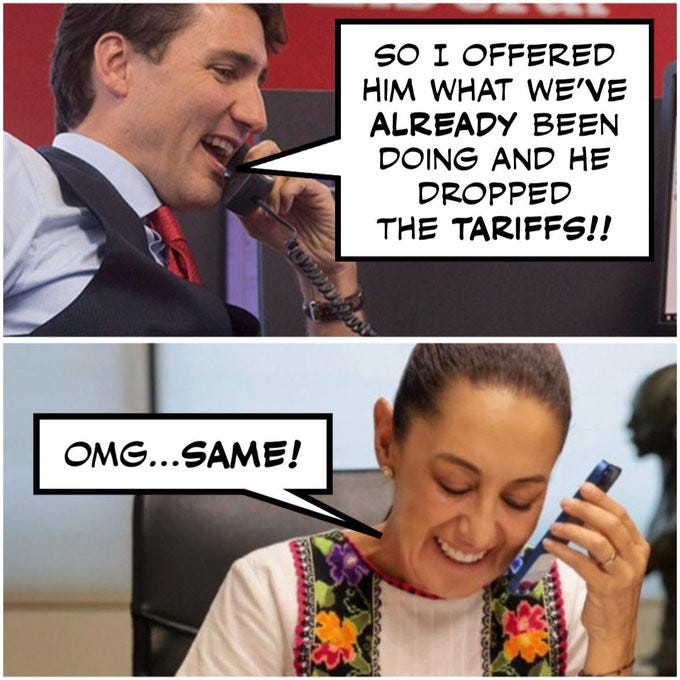The announcement after which fast capitulation by President Trump on his tariffs on Canada and Mexico (however not China!) engendered a specific amount of mockery on Bluesky. At first, road economists had been mocked for not predicting the tariff strikes. Then the capitulation generated a spherical of “informed you so’s” by individuals defending the road economists. This text primarily discusses the normalcy bias of road analysis, after which finishes off with feedback by an enraged Canadian on newest occasions.
Normalcy Bias at Central Banks
All institutional financial (and monetary) analysis passes via casual inner filters earlier than it’s launched to the general public. Inside disputes are papered over, and the analysis is tilted to suit the targets of the establishment. The researchers working at these establishments know what these filters are, and so their pondering will naturally have a tendency to evolve to them. In case you are a critical shopper of such analysis, you might want to bear in mind that these filters exist, and ideally know what they’re.
Earlier than discussing the extra sophisticated case of personal sector analysis, I’ll first talk about how filters present up in central financial institution financial outlooks.
-
Central bankers will keep away from predicting recessions, on the idea that if the central financial institution is panicking, the remainder of the personal sector will soar in on the panic. They could be pressured into it by a recession consequence being extraordinarily apparent (or already quietly underway), however they aren’t going to be forward of the consensus.
-
Inflation-targeting central banks will at all times predict that inflation will return to focus on on the finish of their forecast horizon. The standard justification for that is that they plan to regulate coverage to make inflation hit goal, which is right when you consider typical theories about rates of interest. Since central bankers will not be going to say that they query typical beliefs about theories of rates of interest, they must hold their baseline situation horizon inflation at goal.
Personal Sector Analysis
Their are two principal courses of public institutional financial analysis — “road analysis” produced by funding banks, and unbiased analysis (an business I labored in earlier than I labored at bond supervisor the place I switched to being a shopper of analysis). (There’s additionally loads of personal sector analysis by people on the web, together with myself.)
Avenue analysis is a advertising and marketing device for funding banks. (Their buying and selling desks fee their very own proprietary analysis — desk analysis.) This results in a comparatively apparent battle of curiosity — one might think about that road analysis is biased in the direction of merchandise that generate probably the most buying and selling and origination charges. Impartial analysis can survive as a result of this bias presumably doesn’t exist there.
The output of those researchers is principally seen within the type of analysis articles and postings (plus media interviews). These articles define the home view of the establishment. In uncommon instances, there might be divergences between analysis articles, however that is typically frowned upon. (It’s considerably embarrassing to have the Chief Economist discussing price hikes on the identical day the Senior Charges Strategist is discussing how you can place for upcoming price cuts.) Nevertheless, for giant purchasers, there may be one other type of output — you possibly can name up your gross sales rep to get you in contact with their financial group to reply technical questions. (That is additionally a great way to get hints at unfiltered views.)
Analysis output is often marketed as street reveals — a pair individuals from the economics group go together with gross sales reps to do a slide present at shopper workplaces. For road analysis, this enables the gross sales individuals to get in contact with merchants and portfolio managers on prime of presenting the analysis (which is why such visits are implicitly worthwhile). For unbiased analysis, you might be hawking analysis subscriptions.
The truth that analysis is used as a gross sales device creates a political normalcy bias. Though the presenters wish to be thought upsetting, you don’t want to open up inner disputes on the agency you might be visiting, or say issues that offend your purchasers. Worst case outcomes are that purchasers scream at you on your views, or two or extra members of the visited agency begin screaming at one another while you’re caught watching. Neither consequence is conducive to gross sales.
The tip result’s a type of normalcy bias. Politics is usually constrained to a bland “yay for neoliberalism and free markets,” though there was some leeway for “yay libertarianism” for gold analysts and the like. (I left the business earlier than MAGA was a factor, so I’m uncertain what the political surroundings is like now.) Nevertheless, since neoliberalism crosses mainstream social gathering borders, you wish to keep away from partisan politics.
Latest Tariff Episode
With the earlier dialogue in thoughts, it was fully unsurprising that the road consensus was for a situation effectively beneath 25% tariffs on Canada and Mexico. There’s each a superb technical cause, in addition to the political normalcy bias.
The technical cause to foretell lower than 25% tariffs was that the coverage was possible unsustainable and shortly reversed, and so the common tariff price over a forecast horizon would find yourself beneath 25%. This common tariff price issues for mechanical evaluation of the direct impact of tariffs — though such an evaluation ignores issues like expectations (which supposedly matter). This technical cause signifies that each side of the “will he elevate tariffs?” can declare victory through the use of totally different definitions (the declaration of tariffs was made, however reversed simply earlier than they took impact).
The political cause is that it might be very laborious to search out an economist that thinks that sustained 25% tariffs on Canada and Mexico could be something apart from a fiasco. It isn’t a terrific concept to inform potential purchasers that the candidate they voted for is about to torch the American financial system (alongside the opposite victims).
Now that tariffs have been introduced and brought on a freakout, researchers will probably be free to make guesses with out worrying as a lot about reactions.
What the Heck Is Going On Now?
Though the tariff battle with China is on, Canada and Mexico received out by doing nearly nothing (meme above). To be truthful to Trump, he did get Canada to comply with appoint a Fentanyl Tsar/Tsarina. Nevertheless, since Canada doesn’t have functionaries who go by Russian aristocratic titles and has a strict hierarchy that culminates in Ministers, I assume this will probably be a mid-level bureaucrat that acts as some extent of contact with the Yanks.

The dearth of 25% tariffs blows an enormous gap in Trump’s financial “plan.” As famous by Erica York on social media, the specter of tariffs can not change revenue taxes. Though the tariffs are solely allegedly delayed, the continued menace of imposing them retains Trump as Public Enemy #1 in Canada. There are already boycott lists circulating, it’s not clear but that bourbon is coming again to provincial liquor shops (and orders to exchange stock may be on maintain), and Canada is scrambling to search out alternate sources of issues like oranges. Preserve the menace stay additionally helps marinate the federal Conservative Occasion as they should hold scrubbing images of themselves in MAGA hats off the web.
In fact, the massive pleasure is that 19 yr olds are crawling within the partitions the Treasury and chewing on wires. Though this is able to be an thrilling film premise and will trigger loads of short-term grief, the present trajectory doesn’t appear to be a sustainable plan of action. Proper now, DOGE is racking up legal liabilities and dangers being thrown underneath the bus by President Trump if the oven will get too scorching.
E mail subscription: Go to https://bondeconomics.substack.com/
(c) Brian Romanchuk 2024



